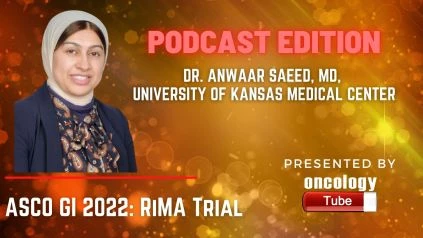Dr. Anwaar Saeed, MD, Associate Professor of Medicine, Division of Medical Oncology, Associate Director- Early Phase Program at University of Kansas Medical Center. In this video, she speaks about the ASCO GI 2022 Abstract CA209-8YD: A phase I/II trial of rucaparib in combination with ramucirumab with or without nivolumab in previously treated advanced gastroesophageal adenocarcinoma (GEA) (RiME).
Origins:
Â
Globally and in the United States, GEA is one of the main causes of cancer-related mortality. Therapeutic options for chemo-refractory GEA are limited, and effectiveness is low. PARP inhibitors have been shown to induce synthetic lethality and reduce tumor burden in in vitro and in vivo models of GEA. About 35 percent of GC have DNA damage response (DDR) gene alterations, and PARP inhibitors have been shown to induce synthetic lethality and reduce tumor burden in in vitro and in vivo models of GEA. In the tumor microenvironment, DDR-deficient tumors had higher tumor mutational burden, tumor infiltrating lymphocytes, and higher chemokine and PD-L1 expression. Antigen presentation is enhanced, pro-inflammatory cytokines are induced, PD-1/PD-L1 expression is influenced, and T- and B-cell activity is modulated when PARP inhibitors like rucaparib are used. Furthermore, the immune modulatory effect of VEGF targeting medicines like ramucirumab has been corroborated by outcomes from various GEA early phase trials. When paired with immune checkpoint inhibitors like nivolumab, we believe that modulating the tumor microenvironment via PARP and VEGF inhibition will boost anti-tumor immunity and lead to therapeutic synergy.
Â
Methodologies:
Â
An open label, two parallel cohorts phase II research will follow a safety lead in phase of 6-9 participants. A total of 52 patients will be enrolled (26 in each cohort). For the safety lead in, a 600 mg BID rucaparib dose will be administered in combination with conventional ramucirumab doses and flat nivolumab doses. If more than one-sixth of the patients in phase II develop DLTs, the dose of rucaparib will be reduced. Participants in cohort A will receive rucaparib at the recommended phase II dose (RP2D) PO twice daily + ramucirumab 8 mg/kg IV every two weeks + nivolumab 480 mg IV every four weeks (28-day cycles). In cohort B, participants will take rucaparib at RP2D PO twice day plus ramucirumab 8mg/kg IV q2w (28-day cycles). Every two cycles, the tumor response will be assessed using modified RECIST v1.1. In a screening 17-gene homologous recombination deficient (HRD) panel, 50% of Pts in each of the two cohorts must have a detrimental tumor gene change in at least one gene. Eligible patients had had at least one course of therapy, had an ECOG PS of 0 to 1, had sufficient organ function, had never taken a PARP inhibitor before, and had MMR-capable tumors with detectable disease. In phases I and II, the primary goals are to determine the RP2D and overall response rate (ORR). Safety, overall benefit rate (OBR), median PFS, OS, and ORR in HRD positive and negative cohorts are secondary goals. The RiME study is presently enrolling participants. Bristol Myers Squibb and Clovis have provided research money for the study. NCT03995017 is the number for the clinical trial.

